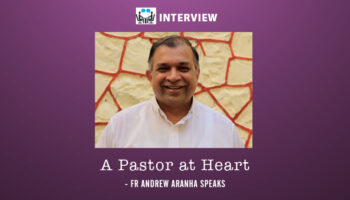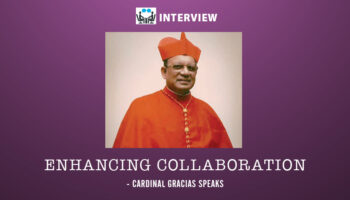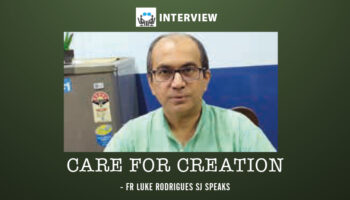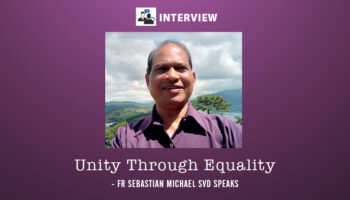In 1982, John, a forty-one year old Squadron Leader of the Indian Air Force, was involved in an air crash during which he went through a near-death experience. He came out of it a transformed man, with a new sense of call and mission. He learnt from reputed Christian and Hindu gurus, and became a sanyasi, and later an acharya in a new tradition. Here is what he shared with MAGNET.
”I was a happy-go-lucky Air Force Officer enjoying my life with the big dreams of starting my own airline and airship industry when I met with an air accident. A personal encounter with the living Spirit of Christ after that transformed my life radically,” says Swami Bharati.
- Please introduce yourself and your mission.
I am an Indian Sanyasi disciple of Sadguru Jesus Christ according to the Chaturashrama Parampara, and an Acharya of a holistic ecological school of thought named ‘Dharma Bharathi.’ My mission is two-fold; to promote a ‘Dharma Rajya Movement’ for helping to establish abiding peace and sustainable development on earth based on the Dharma Bharathi school of thought, and to help promote an ‘Indian face’ of the Christian faith, also based on the Dharma Bharathi school of thought.
- Please explain the term
The term ‘Sadguru’ here implies the True Guru who can lead us from falsehood to truth, from darkness to light and from death to immortality in answer to our prayer, ‘Asathoma Sadgamaya, Tamasoma Jyotirgamaya, Mrityorma Amritamgamaya’. The qualities and attributes of the Sadguru are defined in the Viswasara Tantra as:
“I bow to the True Guru
Who is the embodiment of the bliss of God, who bestows supreme happiness, the Absolute who is wisdom incarnate;
Who is beyond any duality, who is vast like the sky, whom ‘Though Art That’ and similar Scriptural verses have in view;
Who is the One, the Eternal, the Pure, the Immovable, the Witness to all;
Who is beyond all bhavas, devoid of the three gunas.”
I accept and present Jesus of Nazareth as the Sadguru, just as he was accepted and presented by the Greek as the ‘Christos’ (anointed one of God) in the beginning of Christianity.
- You said that you are an Indian Sanyasi disciple of Sadguru Jesus Christ according to the Chaturashranm Parampara. Can you please explain ?
I am now a ‘senior citizen’ of India. I am economically sustained and supported by the Government of India with a good monthly pension for the services that I had rendered to the nation as an officer in the Indian Air Force. I was just a 41-year old Squadron Leader when I had sought and received ‘premature retirement’ from active service in May 1989 to devote myself fully for my new-found mission of peace-building as a disciple of Sadguru Jesus Christ, the Prince of peace. Today I am a 70-year old Indian Sanyasi. I am ever grateful to God for giving me birth in India. I consider being an Indian a great blessing.
The Chaturashrama Parampara of India is an ancient tradition that sees human life in this world as a pilgrimage from the womb of one’s human mother to the womb of Mother Earth with four distinct yet continuous ashramas (stages). ‘Chatur’ means four. ‘Parampara’ means age-old tradition. All human beings are called to follow the Chaturashrama Parampara in their lives. There is no religious connotations involved in this call. It is open to all people of goodwill. It will save the world from the temptations of consumerism and materialism. The four ashramas are Brahamacharyashrama (stage of celibate student life), Grahasthashrama (stage of married family life), Vanaprasthashrama (stage of contemplative life in the forest) & and Sanyasashrama (stage of total renunciation as a preparation for the final departure from this world). I have modified the third stage as ‘Sevashrama’ which is envisaged as a stage of selfless, voluntary and grateful service to the society for what we have received from the society. The one who is living in the Sanyasashrama is termed a ‘Sanyasi’. I am a Sanyasi according to this ancient Indian tradition. I am also an Indian who has been striving incessantly to be an authentic disciple of Sadguru Jesus Christ.
- You have also said that you are an Acharya of a holistic ecological school of thought named Dharma Bharathi. Please explain.
The term Acharya here implies a teacher who propounds and promotes a new school of thought.
I have initiated the Bharathi Chaturashram Sanyasa Parampara. I am also the Acharya of this new Sanyasa Parampara which has Pancha Vratha and Pancha Dharma as its ‘Rule of life’. Pancha Vratha consists of Ahimsa, Satya, Ashteya, Aparigraha & Brahmacharya (Non-violence, Truthfulness, Frugality, Non-possession & Celibacy). Pancha Dharma consists of Prarthana, Padhana, Pravarthana, Prabodhana & Protsahana ( Prayer, Study, Action, Instruction & Appreciation).
I was known as Squadron Leader N. V. John. ‘Squadron Leader’ was my Rank in the Indian Air Force. After my encounter with the living Spirit of Christ following a near death experience in an air accident in 1982, I was guided by the Lord to Fr. Bede Griffiths OSB at his Saccidananda Ashram near Trichy in Tamil Nadu. Fr. Bede Griffiths was a British Benedictine monk who had made India his ‘spiritual home’ and took the Indian name ‘Swami Dayananda.’ I received Sadhak deeksha from Swami Dayananda in 1984 with the name ‘John Sachidanand.’ I was also given Acharya deeksha by him in 1990.
I entered the Sanyasarama in 2001 with the written permission of my wife and the blessings of Swami Ranganathananda, my Hindu guru who was the International President of the Ramakrishna Mission at that time. I received two sets of saffron dresses from him on 25th Nov 2001 in Belur Math, the International Headquarters of the Ramakrishna Mission. One was old and the other was new. They signified that I must be rooted in the enlightened spiritual and cultural traditions of India and yet fully open to the new developments in human thought. He suggested to me that, as I do not come within any of the established traditions of Sanyasis in India at present, I should initiative a tradition of my own. I initiated the ‘Bharathi’ Chaturashrama Sanyasa Parampara in 2003 and took the Sanyasa name ‘Swami Sachidananda Bharathi’. I am the Founder and Acharya-guru of Dharma Bharathi school of thought and ‘Bharathi’ Chaturashram Sanyasa Parampara.
- You have also been promoting a ‘Second Freedom Struggle of India.’ What is it?
Though India had won her political freedom in 1947, she is yet to win the economic, social and moral freedoms if she is to achieve the goal of ‘Purna Swaraj.’ Mahatma Gandhi had also pointed out this fact. Political freedom, economic freedom, social freedom and moral freedom are the four pillars of ‘Purna Swaraj’. Out of these, we had won political freedom. But with 30% of India’s 1280 million population still living below poverty line, we are far from economic freedom. With the divisive and violent casteism and communalism in India, social freedom for us remains an utopia. With the all-pervasive corruption and injustice, moral freedom is also only a mirage.
“Congress has won political freedom, but it has yet to win economic freedom, social and moral freedoms. These freedoms are harder than the political, if only because they are constructive, less exciting and not spectacular.” These words of Mahatma Gandhi call for a Second Freedom Struggle to win the remaining economic, social and moral freedoms that are yet to be won for India.
In 2006 I received an ‘inner call’ to leave our Dharma Bharathi Ashram at Mulanthuruthy near Kochi in Kerala (where I was staying at that time) and undertake a year-long pilgrimage of peace across India during the 60th anniversary of Indian Independence with the message of a Second Freedom Struggle for a ‘hunger-free, caste-free and corruption-free India’. This year-long pilgrimage of peace was termed ‘Desh Vandana-2007.’
During it, I travelled across the length and breadth of India for a whole year and addressed and interacted with staff and students of 26 Universities and more than 100 Colleges and High Schools in the country. I also interacted with a large number of NGOs, Religious Communities, Civil Society Groups, Youth & Women Organizations, Rotary & Lions Clubs, YMCAs & YWCAs, Gandhian Organizations, etc.
The Second Freedom Struggle for a hunger-free, caste-free and corruption-free India was initiated in the concluding interreligious prayer meeting of Desh Vandana-2007 at Gandhi Mandapam, Kanyakumari, on 30th January 2008.
After that, I wrote a book titled The Second Freedom Struggle of India. A Hunger-free India Campaign was also initiated. Over the years our Dharma Bharati Mision has been doing a great amount of work to achieve this goal and has received a number of Awards for its dedicated service for the poor and down trodden in the slums of Mumbai. (See www.dbmindia.org for details).
I came to realize that without interreligious cooperation and communal harmony the Second Freedom Struggle will remain only an utopian dream. Tyagarchana Shanti Mission (TSM) was started by me in 2014 to promote interreligious cooperation and communal harmony in India. I have been working in UP for 3 years for promoting the goal of TSM.
My latest book is titled Vision 2030: Purna Swaraj. It presents the outlines of a vision, ideology and action plan that can help us to win the Purna Swaraj for India by 2030. My forthcoming book, Second Freedom Struggle, presents five Christo-Gandhian principles and three Core Campaigns for the Second Freedom Struggle to achieve this goal.
- How can we combat the growing communalism in India today?
We need to present and promote an inclusive vision and a holistic philosophy. Without it, sectarian narratives will gain strength in the country, leading to conflicts and violence. ‘He drew a small circle and kept me out. I drew a large circle and brought him in.’ This wisdom of ancient India needs to be given practical expressions in our present context. The Hindu Rashtra vision and the ‘Hindutva’ ideology are sectarian narratives. They have no roots in India’s enlightened spiritual and cultural traditions. We need to promote in their place the inclusive vision of a Dharma Rajya and the holistic philosophy of Dharmodaya which have deep roots in our spiritual and cultural traditions. This is what I have been trying to do. Also, we need to bring about radical changes in our socio-economic and political systems and institutions. This calls for a Second Freedom Struggle, much more difficult and challenging than the first.
- What is the initiative called Khushhaal Bachpan Abhiyaan that you launched recently?
Khushhaal Bachpan Abhiyaan is termed ‘Happy Childhood Campaign’ in English. It is an interreligious campaign of love for happy and healthy childhood for all children below eighteen years of age in India based on the ‘Happy Childhood Pledge’ adopted in the first Interreligious Parliament for Peace & Sustainable Development organized by Tyagarchana Shanti Mission at Patna on 4 & 5 Aug 2017.
Khsuhhaal Bachpan Abhiyaan is the first non-violent campaign of the Second Freedom Struggle, just as the Champaran Satyagraha was the first non-violent campaign of the first freedom struggle of India. It has four objectives: caring love, nutritious food, creative learning & playing, singing and dancing for all children.
- Why do we need this campaign in India today?
Because the children in India today are the worst affected victims of injustice, exploitation and oppression.
The condition of children in India today is miserable. In the name of ‘education’ we are ruining the lives of our children. They are burdened with books and subjects that have very little relevance to their life. We are denying to our children the simple joys of childhood in the name of ‘education.’
India has the largest number of children suffering from malnutrition and ill health in the world today. An estimated 6000 children die daily in India due to sicknesses caused by malnutrition. More than twenty million children in India go to bed hungry every day. India also has the largest number of illiterate children in the world.
It is also a shameful and painful reality that India accounts for the largest number of children forced into child marriage and child labour. Further, India also has the largest number of children victimized by child trafficking and sexual abuse. Delhi, the Capital city of India, has become the most unsafe place for children in the world.
- Why does this campaign need to be interreligious?
It is because India is a multi-religious country and nothing in India really grows unless it appeals to the religious sense of the Indian people. Attitudinal changes and value-orientations can be achieved better in India through a religious approach.
Children are the most precious gift of God to humanity. “Every child comes with the message that God is not discouraged of man,” pointed out Rabindranath Tagore. “If you want peace in the world, begin with the children,” taught Mahatma Gandhi. The future of the world is the legacy of the children. Children are pure and innocent. In, with and through them we can see the face of God who is ever active in human history and in the whole creation. It is in the purity of our hearts that we can see the face of God. Children are embodiments of purity and innocence. Because of their purity, children reflect the face of God more visibly and clearly than anyone or anything else in the world.
Happy, healthy and peaceful children will constitute the best measure and most reliable standard of a nation’s true development. They will also constitute the strongest foundation of a culture of abiding peace and sustainable development on earth. The United Nations & G20 have now come to realize the need of inter-religious cooperation. The Millennium World Peace Summit of Religious and Spiritual Leaders in August 2000 that signed the ‘Commitment to Global Peace’ and the UN Summit in 2015 that adopted the 17 ‘Sustainable Development Goals’ are fruits of this realization by the United Nations.
- You are now withdrawing from all national activities and shifting back to your Kerala Ashram. Then how will the Second Freedom Struggle be taken forward?
I had already announced that I would be withdrawing from hectic activity involving a great deal of travel after my 70th birthday, which is on 25th November 2017. I have now shifted from our Navasrushti Ashram near Nagpur to Dharma Bharathi Ashram near Kochi in Kerala with the hope of working to give concrete practical expressions to my vision and mission in the limited context of Kerala. My roots are in Kerala and in the Syro-Malabar Church. Hence, I feel called to devote the twilight years of my life in Kerala working with the Syro-Malabar Church for the Second Freedom Struggle, which is the first stage in the Dharma Rajya Movement envisioned in my earlier book, The Air Plot. Kerala seems to be a fertile ground for such a focused mission.
- What do you think is the role of the Church in the mission promoted by you?
The mission promoted by me is not my mission. It is the mission of the living Spirit of Christ. Hence, it is the mission of the Church. The Lord has only used me to initiate it. I had never even imagined I would come into such a mission and life-vocation.
What I am today and what I have done, and what I have written so far…. all this has been basically inspired by the living Spirit of Christ. But my own limitations and weaknesses also have crept into them. The Lord will correct and purify them in course of time through others who are more holy and enlightened than me.
What the Lord has begun through me is for and on behalf of the Church. I am a son of the Catholic Church and a member of the Syro-Malabar Church. Hence, I will try to inspire the Syro-Malabar Church to take it forward as guided by the living Spirit of Christ.
I have also founded and registered an ecumenical communion of love termed ‘Disciples of Christ for Peace’ (DCP) that will try fearlessly and prayerfully to take the mission forward.
To subscribe to the magazine Contact Us





